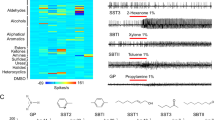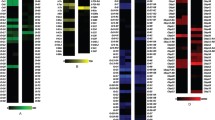Abstract
The yellow fever mosquito, Aedes aegypti, is a vector of many human diseases such as yellow fever, dengue fever, and Zika. As insecticide resistance has been widely reported, chemical repellents have been adopted as alternative options for mosquito and mosquito-borne disease control. This study characterized the responses of olfactory receptor neurons (ORNs) in different types of antennal olfactory sensilla in Ae. aegypti to 48 chemicals that exhibited repellent activity in various insect species. Both excitatory and inhibitory responses were observed from ORNs in response to these chemicals and differential tuning properties were also observed among ORNs. Remarkable excitatory responses were recorded from the ORNs in sensilla SST1, SST2, SBTI, SBTII, and LST2, while inhibitory activities were detected from a neuron in sensillum SST2 in response to several terpene/terpenoid compounds. Moreover, the temporal dynamics of neuronal responses were found to be compound-specific and concentration-dependent. Hierarchical cluster analysis and principal component analysis of the response to each compound across ORNs in seven types of olfactory sensilla in Ae. aegypti revealed that odor reception depended not only on chemical class but also specific chemical structure. Results of this study give new insights into the sensory physiology of Aedes mosquitoes to the chemical repellents and should contribute to the development of new repellent reagents for human protection.




Similar content being viewed by others
References
Ansari MA, Vasudevan P, Tandon M, Razdan RK (2000) Larvicidal and mosquito repellent action of peppermint (Mentha piperita) oil. Bioresour Technol 71:267–271
Boeckh J, Kaissling KE, Schneider D (1965) Insect olfactory receptors. Cold Spring Harb Symp Quant Biol 30:263–280
Campbell C, Gries R, Gries G (2011) Forty-two compounds in eleven essential oils elicit antennal responses from Aedes aegypti. Entomol Exp Appl 138:21–32
Cao LH, Yang D, Wu W, Zeng X, Jing BY, Li MT, Qin SS, Tang C, Tu YH, Luo DG (2017) Odor-evoked inhibition of olfactory sensory neurons drives olfactory perception in Drosophila. Nat Commun 8:1–13
Carey AF, Wang G, Su CY, Laurence JZ, Carlson JR (2010) Odorant reception in the malaria mosquito Anopheles gambiae. Nature 464:66–71
De Bruyne M, Foster K, Carlson JR (2001) Odor coding in the Drosophila antenna. Neuron 30:537–552
DeGennaro M, McBride CS, Seeholzer L, Nakagawa T, Dennis EJ, Goldman C, Jasinskiene N, James AA, Vosshall LB (2013) Orco mutant mosquitoes lose strong preference for humans and are not repelled by volatile DEET. Nature 498:487–491
Den Otter CJ, Behan M, Maes FW (1980) Single cell responses in female Pieris brassicae (Lepidoptera: Pieridae) to plant volatiles and conspecific egg odours. J Insect Physiol 26:465–472
Fradin MS, Day JF (2002) Comparative efficacy of insect repellents against mosquito bites. N Engl J Med 347:13–18
Gertler S (1946) Nu, nu-diethylbenzamide as an insect repelle. US Pat 2,408,389. Washington DC: U.S. Patent and Trademark Office
Ghaninia M, Ignell R, Hansson BS (2007) Functional classification and central nervous projections of olfactory receptor neurons housed in antennal trichoid sensilla of female yellow fever mosquitoes, Aedes aegypti. Eur J Neurosci 26:1611–1623
Gubler DJ (2004) The changing epidemiology of yellow fever and dengue, 1900 to 2003: full circle? Comp Immunol Microbiol Infect Dis 27:319–330
Hallem EA, Carlson JR (2006) Coding of odors by a receptor repertoire. Cell 125:143–160
Hill S, Hansson BS, Ignell R (2009) Characterization of antennal trichoid sensilla from female southern house mosquito, Culex quinquefasciatus say. Chem Senses 34:231–252
Isman MB (2006) Botanical insecticides, deterrents, and repellents in modern agriculture and an increasingly regulated world. Annu Rev Entomol 51:45–66
Joseph RM, Carlson JR (2015) Drosophila chemoreceptors: a molecular interface between the chemical world and the brain. Trends Genet 31:683–695
Laurent G, Wehr M, Davidowitz H (1996) Temporal representations of odors in an olfactory network. J Neurosci 16:3837–3847
Lei H, Christensen TA, Hildebrand JG (2004) Spatial and temporal organization of ensemble representations for different odor classes in the moth antennal lobe. J Neurosci 24:11108–11119
Liu N (2015) Insecticide resistance in mosquitoes: impact, mechanisms, and research directions. Annu Rev Entomol 60:537–559
Liu F, Liu N (2015) Human odorant reception in the common bed bug, Cimex lectularius. Sci Rep 5:15558
Liu F, Chen L, Appel AG, Liu N (2013) Olfactory responses of the antennal trichoid sensilla to chemical repellents in the mosquito, Culex quinquefasciatus. J Insect Physiol 59:1169–1177
Liu F, Haynes KF, Appel AG, Liu N (2014) Antennal olfactory sensilla responses to insect chemical repellents in the common bed bug, Cimex lectularius. J Chem Ecol 40:522–533
Liu F, Xiong C, Liu N (2017) Chemoreception to aggregation pheromones in the common bed bug, Cimex lectularius. Insect Biochem Mol Biol 82:62–73
Marchette N, Garcia R, Rudnick A (1969) Isolation of Zika virus from Aedes aegypti mosquitoes in Malaysia. Am J Trop Med Hyg 18:411–415
Matthews BJ, McBride CS, DeGennaro M, Despo O, Vosshall LB (2016) The neurotranscriptome of the Aedes aegypti mosquito. BMC Genomics 17:32
McBride CS, Baier F, Omondi AB, Spitzer SA, Lutomiah J, Sang R, Ignell R, Vosshall LB (2014) Evolution of mosquito preference for humans linked to an odorant receptor. Nature 515:222–227
McIver S (1978) Structure of sensilla trichodea of female Aedes aegypti with comments on innervation of antennal sensilla. J Insect Physiol 24:383–390
Monath TP (2001) Yellow fever: an update. Lancet Infect Dis 1:11–20
Nakagawa T, Sakurai T, Nishioka T (2005) Insect sex-pheromone signals mediated by specific combinations of olfactory receptors. Science 307:1638–1642
Qiu Y, Van Loon JJ, Takken W, Meijerink J, Smid HM (2006) Olfactory coding in antennal neurons of the malaria mosquito, Anopheles gambiae. Chem Senses 31:845–863
Sato K, Pellegrino M, Nakagawa T, Nakagawa T, Vosshall LB, Touhara K (2008) Insect olfactory receptors are heteromeric ligand-gated ion channels. Nature 452:1002–1006
Stopfer M, Bhagavan S, Smith BH, Laurent G (1997) Impaired odor discrimination on desynchronization of odor–encoding neural assemblies. Nature 390:70–74
Trongtokit Y, Rongsriyam Y, Komalamisra N, Apiwathnasorn C (2005) Comparative repellency of 38 essential oils against mosquito bites. Phytother Res 19:303–309
Ufkes LL, Grams GW (2007) The isolation and identification of volatile insect repellents from the fruit of the Osage orange (Maclura pomifera). J Essent Oil Res 19:167–170
von Butenandt A, Beckmann R, Stamm D, Hecker E (1959) Über den Sexual-Lockstoff des Seidenspinners Bombyx mori. Reindarstellung und Konstitution. Z Naturforsch 14b:283–284
Acknowledgements
This project was supported by Award Alabama Agricultural Experiment Station (AAES) Multistate/Hatch Grants ALA08-045 and ALA015-1-10026 to N.L. The Orlando strain used in this study was a generous gift from Dr. James Becnel (USDA, ARS, Mosquito and Fly Research Unit). The authors thank two anonymous reviewers for their valuable comments on the manuscript.
Funding
This project was supported by Award Alabama Agricultural Experiment Station (AAES) Multistate/Hatch Grants ALA08–045 and ALA015–1-10026 to N.L.
Author information
Authors and Affiliations
Contributions
Conceived and designed the study: NL, ZC, and F.L. Performed the experiments: ZC. Prepared the materials: NL. Wrote the paper: NL, ZC, and FL.
Corresponding author
Ethics declarations
Conflict of Interest
The authors declare that they have no conflict of interests.
Electronic supplementary material
ESM 1
(DOCX 40 kb)
Rights and permissions
About this article
Cite this article
Chen, Z., Liu, F. & Liu, N. Neuronal Responses of Antennal Olfactory Sensilla to Insect Chemical Repellents in the Yellow Fever Mosquito, Aedes aegypti. J Chem Ecol 44, 1120–1126 (2018). https://doi.org/10.1007/s10886-018-1022-5
Received:
Revised:
Accepted:
Published:
Issue Date:
DOI: https://doi.org/10.1007/s10886-018-1022-5




